stop start CHEVROLET KODIAK 2007 Owners Manual
[x] Cancel search | Manufacturer: CHEVROLET, Model Year: 2007, Model line: KODIAK, Model: CHEVROLET KODIAK 2007Pages: 430, PDF Size: 6.06 MB
Page 10 of 430
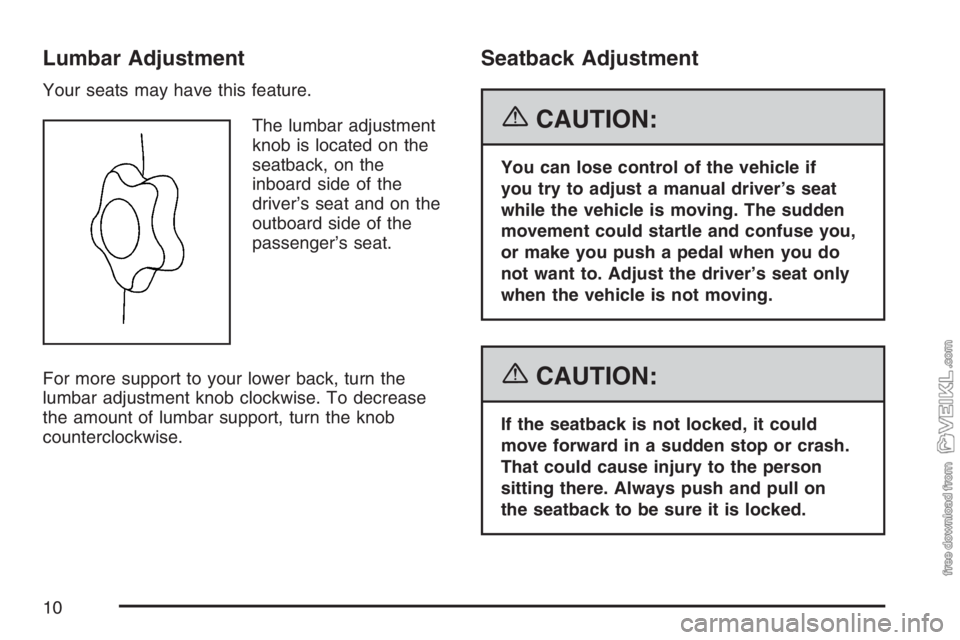
Lumbar Adjustment
Your seats may have this feature.
The lumbar adjustment
knob is located on the
seatback, on the
inboard side of the
driver’s seat and on the
outboard side of the
passenger’s seat.
For more support to your lower back, turn the
lumbar adjustment knob clockwise. To decrease
the amount of lumbar support, turn the knob
counterclockwise.
Seatback Adjustment
{CAUTION:
You can lose control of the vehicle if
you try to adjust a manual driver’s seat
while the vehicle is moving. The sudden
movement could startle and confuse you,
or make you push a pedal when you do
not want to. Adjust the driver’s seat only
when the vehicle is not moving.
{CAUTION:
If the seatback is not locked, it could
move forward in a sudden stop or crash.
That could cause injury to the person
sitting there. Always push and pull on
the seatback to be sure it is locked.
10
Page 95 of 430
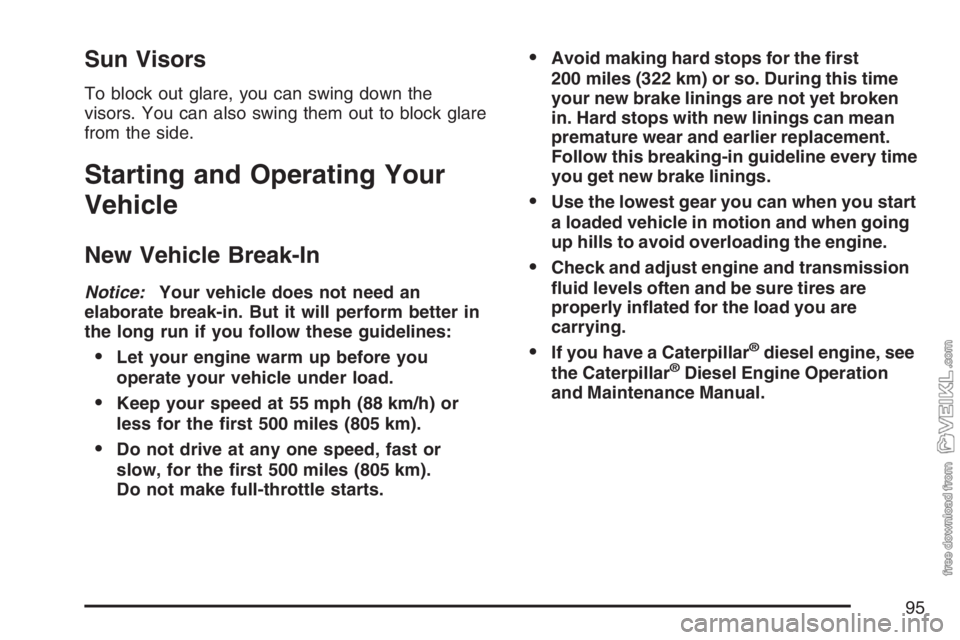
Sun Visors
To block out glare, you can swing down the
visors. You can also swing them out to block glare
from the side.
Starting and Operating Your
Vehicle
New Vehicle Break-In
Notice:Your vehicle does not need an
elaborate break-in. But it will perform better in
the long run if you follow these guidelines:
Let your engine warm up before you
operate your vehicle under load.
Keep your speed at 55 mph (88 km/h) or
less for the �rst 500 miles (805 km).
Do not drive at any one speed, fast or
slow, for the �rst 500 miles (805 km).
Do not make full-throttle starts.
Avoid making hard stops for the �rst
200 miles (322 km) or so. During this time
your new brake linings are not yet broken
in. Hard stops with new linings can mean
premature wear and earlier replacement.
Follow this breaking-in guideline every time
you get new brake linings.
Use the lowest gear you can when you start
a loaded vehicle in motion and when going
up hills to avoid overloading the engine.
Check and adjust engine and transmission
�uid levels often and be sure tires are
properly in�ated for the load you are
carrying.
If you have a Caterpillar®diesel engine, see
the Caterpillar®Diesel Engine Operation
and Maintenance Manual.
95
Page 98 of 430
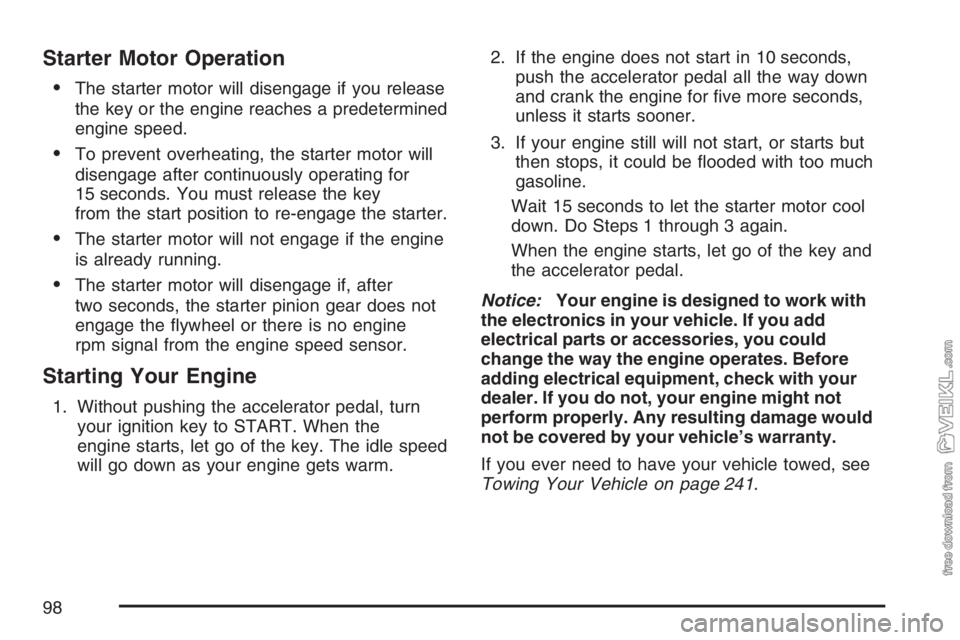
Starter Motor Operation
•The starter motor will disengage if you release
the key or the engine reaches a predetermined
engine speed.
•To prevent overheating, the starter motor will
disengage after continuously operating for
15 seconds. You must release the key
from the start position to re-engage the starter.
•The starter motor will not engage if the engine
is already running.
•The starter motor will disengage if, after
two seconds, the starter pinion gear does not
engage the flywheel or there is no engine
rpm signal from the engine speed sensor.
Starting Your Engine
1. Without pushing the accelerator pedal, turn
your ignition key to START. When the
engine starts, let go of the key. The idle speed
will go down as your engine gets warm.2. If the engine does not start in 10 seconds,
push the accelerator pedal all the way down
and crank the engine for five more seconds,
unless it starts sooner.
3. If your engine still will not start, or starts but
then stops, it could be flooded with too much
gasoline.
Wait 15 seconds to let the starter motor cool
down. Do Steps 1 through 3 again.
When the engine starts, let go of the key and
the accelerator pedal.
Notice:Your engine is designed to work with
the electronics in your vehicle. If you add
electrical parts or accessories, you could
change the way the engine operates. Before
adding electrical equipment, check with your
dealer. If you do not, your engine might not
perform properly. Any resulting damage would
not be covered by your vehicle’s warranty.
If you ever need to have your vehicle towed, see
Towing Your Vehicle on page 241.
98
Page 99 of 430
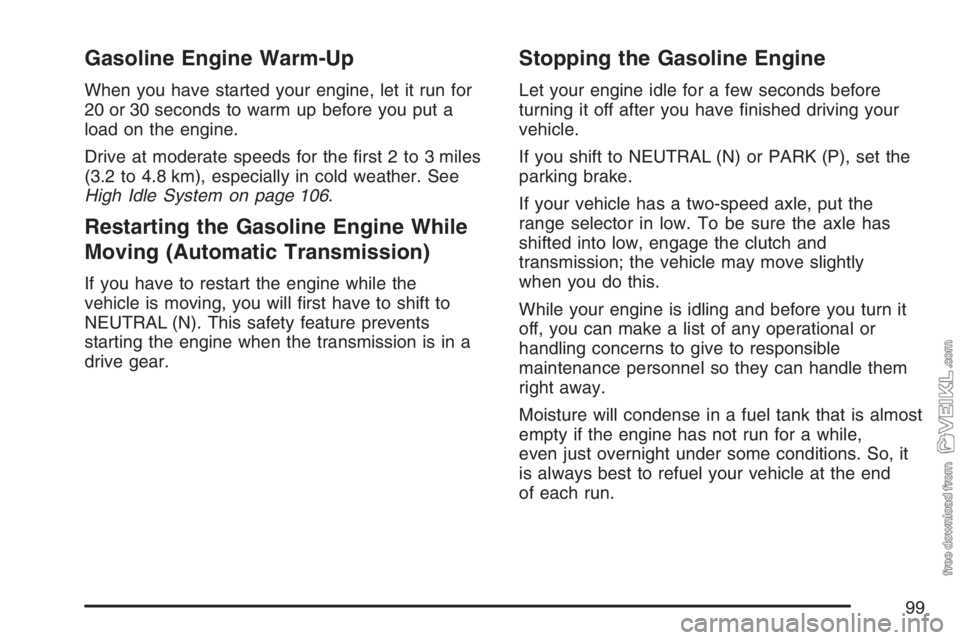
Gasoline Engine Warm-Up
When you have started your engine, let it run for
20 or 30 seconds to warm up before you put a
load on the engine.
Drive at moderate speeds for the first 2 to 3 miles
(3.2 to 4.8 km), especially in cold weather. See
High Idle System on page 106.
Restarting the Gasoline Engine While
Moving (Automatic Transmission)
If you have to restart the engine while the
vehicle is moving, you will first have to shift to
NEUTRAL (N). This safety feature prevents
starting the engine when the transmission is in a
drive gear.
Stopping the Gasoline Engine
Let your engine idle for a few seconds before
turning it off after you have finished driving your
vehicle.
If you shift to NEUTRAL (N) or PARK (P), set the
parking brake.
If your vehicle has a two-speed axle, put the
range selector in low. To be sure the axle has
shifted into low, engage the clutch and
transmission; the vehicle may move slightly
when you do this.
While your engine is idling and before you turn it
off, you can make a list of any operational or
handling concerns to give to responsible
maintenance personnel so they can handle them
right away.
Moisture will condense in a fuel tank that is almost
empty if the engine has not run for a while,
even just overnight under some conditions. So, it
is always best to refuel your vehicle at the end
of each run.
99
Page 100 of 430
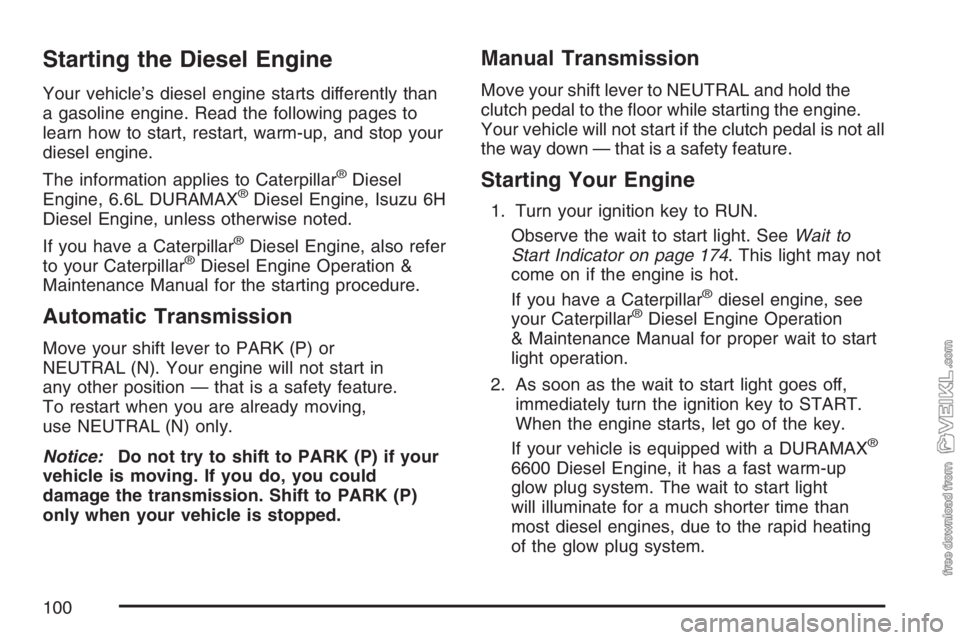
Starting the Diesel Engine
Your vehicle’s diesel engine starts differently than
a gasoline engine. Read the following pages to
learn how to start, restart, warm-up, and stop your
diesel engine.
The information applies to Caterpillar
®Diesel
Engine, 6.6L DURAMAX®Diesel Engine, Isuzu 6H
Diesel Engine, unless otherwise noted.
If you have a Caterpillar
®Diesel Engine, also refer
to your Caterpillar®Diesel Engine Operation &
Maintenance Manual for the starting procedure.
Automatic Transmission
Move your shift lever to PARK (P) or
NEUTRAL (N). Your engine will not start in
any other position — that is a safety feature.
To restart when you are already moving,
use NEUTRAL (N) only.
Notice:Do not try to shift to PARK (P) if your
vehicle is moving. If you do, you could
damage the transmission. Shift to PARK (P)
only when your vehicle is stopped.
Manual Transmission
Move your shift lever to NEUTRAL and hold the
clutch pedal to the floor while starting the engine.
Your vehicle will not start if the clutch pedal is not all
the way down — that is a safety feature.
Starting Your Engine
1. Turn your ignition key to RUN.
Observe the wait to start light. SeeWait to
Start Indicator on page 174. This light may not
come on if the engine is hot.
If you have a Caterpillar
®diesel engine, see
your Caterpillar®Diesel Engine Operation
& Maintenance Manual for proper wait to start
light operation.
2. As soon as the wait to start light goes off,
immediately turn the ignition key to START.
When the engine starts, let go of the key.
If your vehicle is equipped with a DURAMAX
®
6600 Diesel Engine, it has a fast warm-up
glow plug system. The wait to start light
will illuminate for a much shorter time than
most diesel engines, due to the rapid heating
of the glow plug system.
100
Page 103 of 430

Stopping the Diesel Engine
1. Set the parking brake and shift to
NEUTRAL (N) or PARK (P).
2. Turn the ignition key to OFF.
If your vehicle has a two-speed axle, see
Two-Speed Rear Axle Electric Shift Control on
page 113.
If you have a Caterpillar
®diesel engine, see your
Caterpillar®Diesel Engine Operation &
Maintenance Manual for additional information.
Diesel Engine Warm-Up
Several factors affect how quickly your diesel
engine warms up. These can include outside
temperature, engine load, idle time and your
vehicle’s option content. Your vehicle may be
equipped with some features that can help
the engine reach operating temperature sooner.
Some of these features are discussed below.Also, remember that an automatic transmission
adds heat to the cooling system through the heat
exchanger in the radiator. Because of this,
vehicles equipped with automatic transmissions
are often able to retain engine coolant heat better
than manual transmission vehicles.
See your Caterpillar
®Operation & Maintenance
manual for additional diesel engine warm-up
information.
If Your Diesel Engine Will Not Start
If you have run out of fuel, seeRunning Out of
Fuel on page 262.
If you are not out of fuel, and your engine will not
start, do this:
Turn your ignition key to RUN. Immediately after
the wait to start light goes off, turn the ignition key
to START.
If the light does not go off, wait a few seconds, then
try starting your engine again. And, see your dealer
as soon as you can for a starting system check.
If the light comes on and then goes off and you
know your batteries are charged, but your engine
still will not start, your vehicle needs service.
103
Page 104 of 430
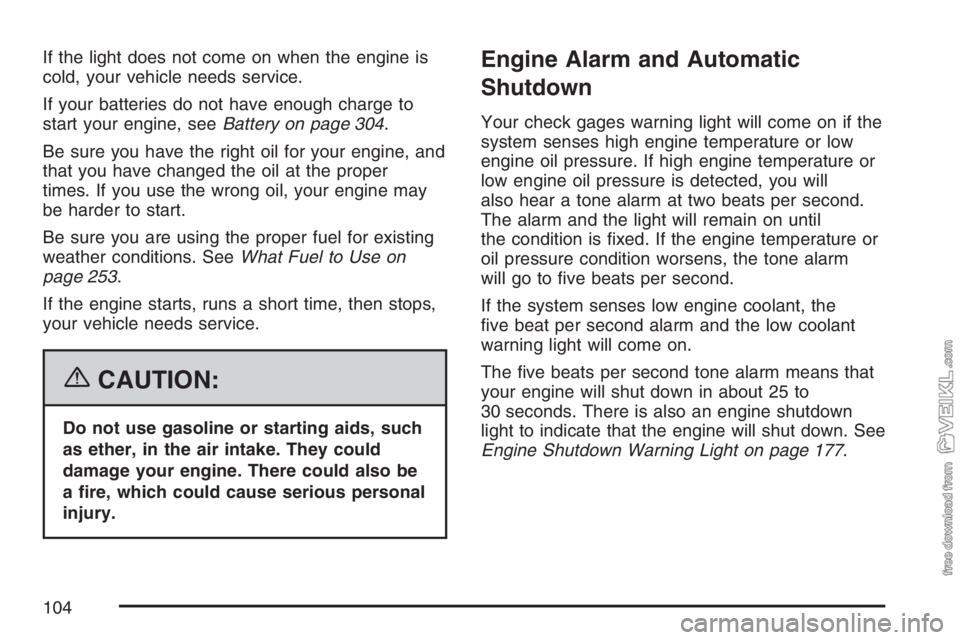
If the light does not come on when the engine is
cold, your vehicle needs service.
If your batteries do not have enough charge to
start your engine, seeBattery on page 304.
Be sure you have the right oil for your engine, and
that you have changed the oil at the proper
times. If you use the wrong oil, your engine may
be harder to start.
Be sure you are using the proper fuel for existing
weather conditions. SeeWhat Fuel to Use on
page 253.
If the engine starts, runs a short time, then stops,
your vehicle needs service.
{CAUTION:
Do not use gasoline or starting aids, such
as ether, in the air intake. They could
damage your engine. There could also be
a �re, which could cause serious personal
injury.
Engine Alarm and Automatic
Shutdown
Your check gages warning light will come on if the
system senses high engine temperature or low
engine oil pressure. If high engine temperature or
low engine oil pressure is detected, you will
also hear a tone alarm at two beats per second.
The alarm and the light will remain on until
the condition is fixed. If the engine temperature or
oil pressure condition worsens, the tone alarm
will go to five beats per second.
If the system senses low engine coolant, the
five beat per second alarm and the low coolant
warning light will come on.
The five beats per second tone alarm means that
your engine will shut down in about 25 to
30 seconds. There is also an engine shutdown
light to indicate that the engine will shut down. See
Engine Shutdown Warning Light on page 177.
104
Page 109 of 430
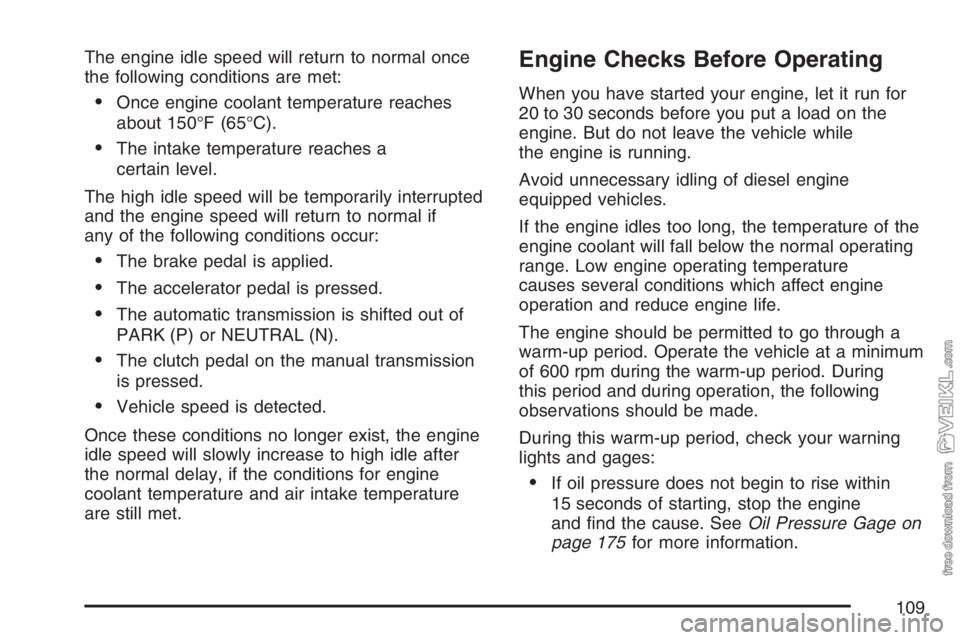
The engine idle speed will return to normal once
the following conditions are met:
•Once engine coolant temperature reaches
about 150°F (65°C).
•The intake temperature reaches a
certain level.
The high idle speed will be temporarily interrupted
and the engine speed will return to normal if
any of the following conditions occur:
•The brake pedal is applied.
•The accelerator pedal is pressed.
•The automatic transmission is shifted out of
PARK (P) or NEUTRAL (N).
•The clutch pedal on the manual transmission
is pressed.
•Vehicle speed is detected.
Once these conditions no longer exist, the engine
idle speed will slowly increase to high idle after
the normal delay, if the conditions for engine
coolant temperature and air intake temperature
are still met.
Engine Checks Before Operating
When you have started your engine, let it run for
20 to 30 seconds before you put a load on the
engine. But do not leave the vehicle while
the engine is running.
Avoid unnecessary idling of diesel engine
equipped vehicles.
If the engine idles too long, the temperature of the
engine coolant will fall below the normal operating
range. Low engine operating temperature
causes several conditions which affect engine
operation and reduce engine life.
The engine should be permitted to go through a
warm-up period. Operate the vehicle at a minimum
of 600 rpm during the warm-up period. During
this period and during operation, the following
observations should be made.
During this warm-up period, check your warning
lights and gages:
•If oil pressure does not begin to rise within
15 seconds of starting, stop the engine
and find the cause. SeeOil Pressure Gage on
page 175for more information.
109
Page 110 of 430
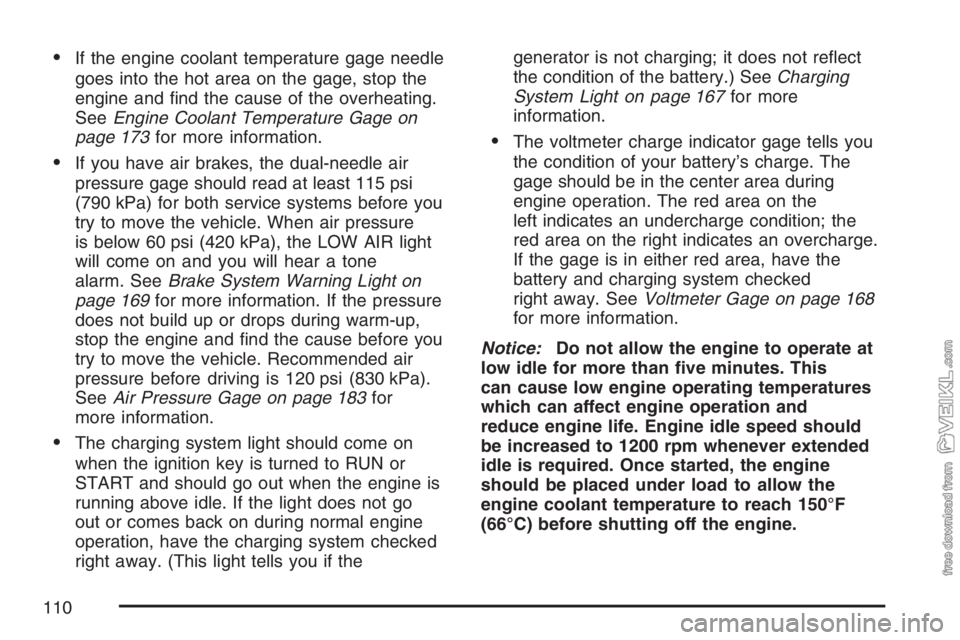
•If the engine coolant temperature gage needle
goes into the hot area on the gage, stop the
engine and find the cause of the overheating.
SeeEngine Coolant Temperature Gage on
page 173for more information.
•If you have air brakes, the dual-needle air
pressure gage should read at least 115 psi
(790 kPa) for both service systems before you
try to move the vehicle. When air pressure
is below 60 psi (420 kPa), the LOW AIR light
will come on and you will hear a tone
alarm. SeeBrake System Warning Light on
page 169for more information. If the pressure
does not build up or drops during warm-up,
stop the engine and find the cause before you
try to move the vehicle. Recommended air
pressure before driving is 120 psi (830 kPa).
SeeAir Pressure Gage on page 183for
more information.
•The charging system light should come on
when the ignition key is turned to RUN or
START and should go out when the engine is
running above idle. If the light does not go
out or comes back on during normal engine
operation, have the charging system checked
right away. (This light tells you if thegenerator is not charging; it does not reflect
the condition of the battery.) SeeCharging
System Light on page 167for more
information.
•The voltmeter charge indicator gage tells you
the condition of your battery’s charge. The
gage should be in the center area during
engine operation. The red area on the
left indicates an undercharge condition; the
red area on the right indicates an overcharge.
If the gage is in either red area, have the
battery and charging system checked
right away. SeeVoltmeter Gage on page 168
for more information.
Notice:Do not allow the engine to operate at
low idle for more than �ve minutes. This
can cause low engine operating temperatures
which can affect engine operation and
reduce engine life. Engine idle speed should
be increased to 1200 rpm whenever extended
idle is required. Once started, the engine
should be placed under load to allow the
engine coolant temperature to reach 150°F
(66°C) before shutting off the engine.
110
Page 118 of 430
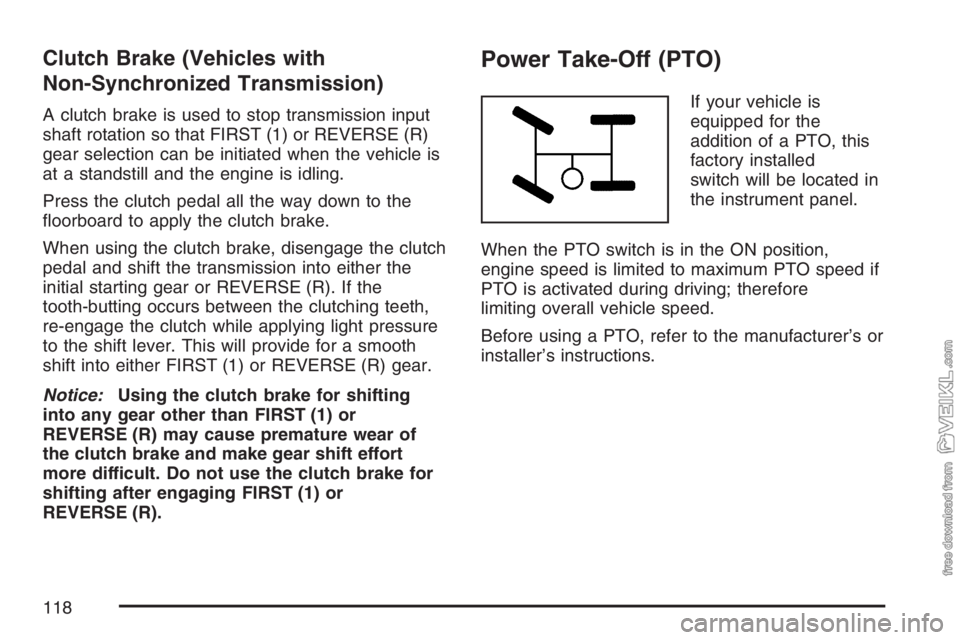
Clutch Brake (Vehicles with
Non-Synchronized Transmission)
A clutch brake is used to stop transmission input
shaft rotation so that FIRST (1) or REVERSE (R)
gear selection can be initiated when the vehicle is
at a standstill and the engine is idling.
Press the clutch pedal all the way down to the
floorboard to apply the clutch brake.
When using the clutch brake, disengage the clutch
pedal and shift the transmission into either the
initial starting gear or REVERSE (R). If the
tooth-butting occurs between the clutching teeth,
re-engage the clutch while applying light pressure
to the shift lever. This will provide for a smooth
shift into either FIRST (1) or REVERSE (R) gear.
Notice:Using the clutch brake for shifting
into any gear other than FIRST (1) or
REVERSE (R) may cause premature wear of
the clutch brake and make gear shift effort
more difficult. Do not use the clutch brake for
shifting after engaging FIRST (1) or
REVERSE (R).
Power Take-Off (PTO)
If your vehicle is
equipped for the
addition of a PTO, this
factory installed
switch will be located in
the instrument panel.
When the PTO switch is in the ON position,
engine speed is limited to maximum PTO speed if
PTO is activated during driving; therefore
limiting overall vehicle speed.
Before using a PTO, refer to the manufacturer’s or
installer’s instructions.
118